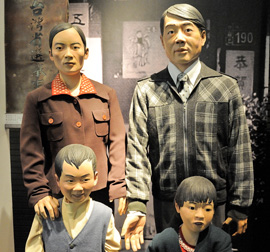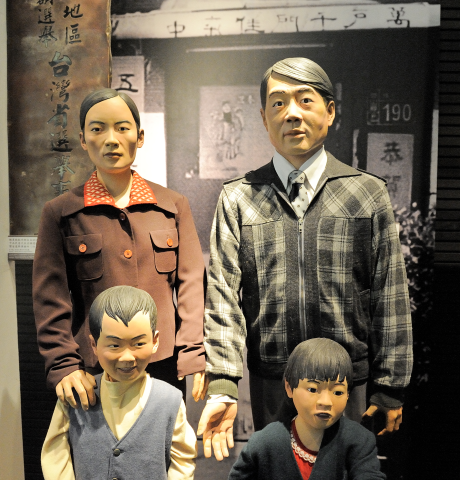:::
The family in Villages of Dependents.
I grew up in a military dependents’ village. Besides my parents, I also have a little sister. The house we lived in when we were little was given a special name, many people called it “zhuliba” (meaning bamboo fence). Mom and dad often told us stories from their younger days. They endured endless hardships and arduous journeys to travel from Shanghai and Chongqing, to finally settle in Taiwan in 1950. When they were chatting, fighting or lecturing us, they often spoke in the Shanghai dialect, a language both my sister and I had a hard time understanding. However, when they were talking to our uncles and aunts, they spoke mostly the Sichuan dialect. Although speaking in dissimilar accents and dialects, my parents and their neighbors had a number of common conversation topics and aspirations, and these often appeared as slogans on the walls of the military dependents’ village, such as “Counterattack Mainland,” or “Anti-Communism and Anti-Russia”.
The sculpture shows common scenes in a military dependents’ village during the 1960s and 70s. Between 1949 and 1952, close to one million military personnel and their dependents arrived in Taiwan with the Nationalist Government, and most of them were basic level military personnel, school workers and government employees. As a result, the existing social structure among the original Taiwanese population of six million people changed significantly. Following the orders of the Nationalist Government, most low level military personnel lived near barracks or airports, in communities known as military dependents’ villages. Surrounded by slogans such as “Counterattack Mainland,” or “Anti-Communism and Anti-Russia”, a family of four usually lived in a simple, single story house, and the parameter of the military dependents’ villages was often surrounded by bamboo fences, with a basketball court being the focus of recreation and entertainment for the entire community. Most men in the military dependents’ villages came from different provinces in China and spoke different dialects, while most mothers were either Taiwanese nationals or members of indigenous tribes, with people communicating mostly in Mandarin. However, the children that grew up in military dependents’ villages went to school and later worked with people from Taiwanese homes, and thus they became the first generation of Taiwanese people in their families.











